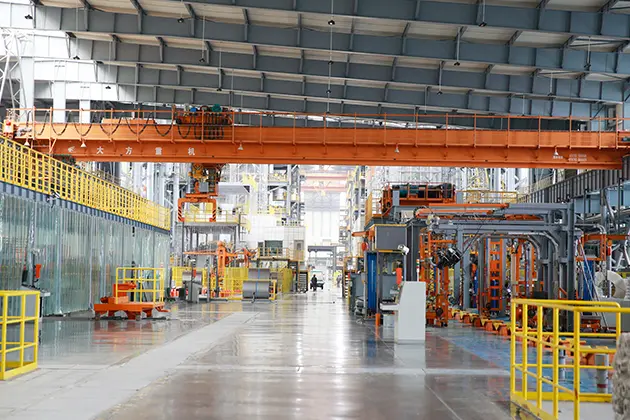With the continuous advancement of technology, overhead cranes play an increasingly important role in various industrial fields. To enhance operational efficiency, safety, and intelligence levels, advanced technologies such as remote control, voice control, big data analysis, anti-sway positioning, and laser scanning imaging are gradually being applied to overhead crane systems. These technologies not only change the traditional operation methods of overhead cranes but also bring higher production efficiency and lower operating costs to enterprises.
Remote Control Technology
Remote control is a method of wireless control of remote equipment using radio signals. The remote control system converts DP communication, Profinet communication, Modbus, and other communication methods in the industrial control network into mobile network signals to achieve wireless control of equipment. The remote control system operates stably and is highly compatible. In any place with network coverage, crane operators can view the operating conditions of the equipment and video screens in real-time via mobile phones or computers. The system also has SMS receiving and control functions. The remote control system can achieve unattended operation and integrated equipment management, greatly reducing post-operation maintenance costs, lowering enterprise operating costs, improving production efficiency, and preventing harm to personnel health due to the working environment. It is commonly used in waste handling cranes, galvanizing cranes and the steel industry cranes.
Laser Scanning Imaging Technology
Laser scanning imaging technology uses laser beams to scan objects and capture the reflected beams to form images based on different reflection sequences. This allows for accurate detection of the size and position of various materials and vehicles. The intelligent recognition system developed based on laser scanning technology can identify materials of any shape. It models according to application scenarios, follows the crane to scan dynamically, and identifies large storage areas in real-time. It boasts fast recognition speed and high accuracy, completing the scanning and recognition process within 1 second with an accuracy of ±10mm. The control system uses laser scanning imaging to manage the crane, achieving material identification, automatic grabbing, and path planning functions. Businesses can use a ZnSe window to protect sensitive laser components while allowing efficient transmission of the beam. This helps maintain imaging accuracy and supports reliable performance in high-speed scanning and recognition systems.
The application of these intelligent technologies not only improves the operational stability and safety of the equipment but also saves a lot of operating and maintenance costs for enterprises. Currently, well-known crane manufacturers such as Konecranes, Weihua, and Dafang Crane have developed various intelligent systems for overhead cranes. In the future, with further technological development, the intelligence level of overhead cranes will continue to improve, providing more intelligent, efficient, and safe solutions for production operations in various industries.
Voice Control Technology
Voice control technology is a new type of technology that realizes human-computer interaction through crane-specific voice recognition software. Users only need to install the voice control module on the equipment and connect the equipment with the remote server. Then, they can control the equipment through voice recognition software, providing a new experience for operators. Dialogue with the equipment is convenient and fast, completing two-way communication between humans and machines. When the equipment malfunctions, it can issue timely alarm warnings to the operator, reminding the staff to stop for maintenance. The voice control system can recognize Chinese and English commands and supports the customization of languages and dialects worldwide, making the equipment truly intelligent. The voice control system can be widely used in environments with complex working conditions such as automobile manufacturing, warehousing, and power plants.
Big Data
Big data refers to massive, high-growth, and diverse information assets that require new processing models to achieve stronger decision-making, insight discovery, and process optimization capabilities. The big data platform consists of a big data control center and equipment enterprise users. It collects vast amounts of equipment data through sensors on lifting equipment, such as operational status and improper operation records. This data is transmitted to manufacturers and custom users via networks or SMS, reflecting the equipment’s operational status and user habits. Through data analysis, companies can better understand customer needs, facilitating product optimization and new product development, and providing personalized customization services. Monitoring equipment status helps identify potential risks, timely notifying customers to avoid significant losses and providing real and effective operational data, contributing to industry development. The big data platform is rapidly evolving and is widely used in steel industry cranes, and warehousing industry cranes.
Anti-sway Positioning Technology
Anti-sway positioning technology uses the acceleration and deceleration of the crane’s trolley to eliminate load sway. The anti-sway positioning system eliminates load swing with no waiting time, making material handling more stable, precise, and efficient. It reduces the load swing amplitude to less than ±2mm at the lowest point, with accurate jog functionality and customizable jog distance according to user needs. Regardless of the crane’s travel distance, the repositioning accuracy is less than ±2mm. The precise automatic positioning function enhances the safety of lifting operations, preventing swaying and collisions during material handling. It ensures smooth deceleration and quick stops from high-speed operation, significantly improving production efficiency. Anti-sway technology is essential for developing fully automated, intelligent cranes, enabling automated material handling. This technology is available on a variety of overhead cranes.










